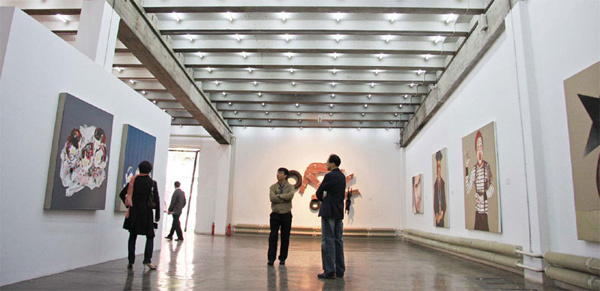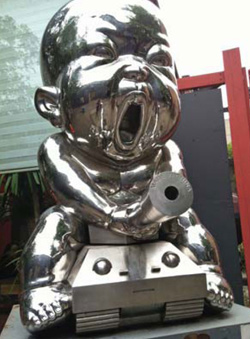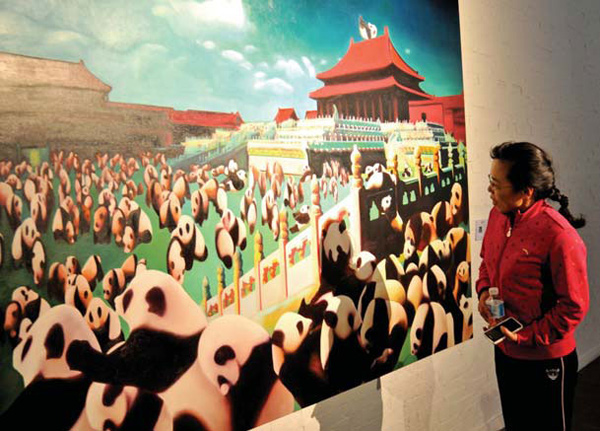An industrial relic turned into a thriving creative arts center that is helping feed a soaring demand for Chinese work
 |
|
Visitors appreciate artworks in a 798 Art Zone gallery, in Beijing's Chaoyang district. Provided to China Daily |
In its heyday 50 years ago it was hailed as one of the best factories in China, with up to 20,000 workers pumping out electronic hardware for military and civilian use. Joint Factory 798 went into terminal decline in the 1980s, and few people today have probably even heard of it. But it was the progenitor of 798 Art Zone, which has blossomed into a venue that enjoys worldwide fame.
The 798 complex, in Chaoyang district, northeast Beijing, has drawn modern and contemporary artists, galleries and institutions from around the globe.
Over the past 10 years the area has become so successful that it is often compared to SoHo in New York, a thriving creative neighborhood full of artists' lofts and galleries. Driven by the booming Chinese art market, art galleries from many countries, including Pace Beijing, the subsidiary of Pace Wildenstein in the United States, and Raab Galerie in Germany, are exploring business and artistic opportunities in China.
The more than 200 art-related organizations clustered in the area make up the most thriving artistic community in China, 798 Art Zone's website says.
|
 A baby sculpture outdoors in the 798 Art Zone area. [Photo by Lin Jing / China Daily] |
Song Xinyu, curator of Raab China, says Raab's decision to open its first overseas branch in China was triggered by the surge in the Chinese art market from 2006 to 2007.
At that time the works of many contemporary artists in 798, such as Yue Minjun and Zhang Xiaogang, sold at auction for millions of dollars in the West.
The market has continued to boom, and according to the Hurun Art List 2012, the value of sales for the top 50 artists was 7.86 billion yuan ($1.24 billion), an increase of 88 percent on the previous year and 4.5 times the figure of 2010.
The Hurun list said that an oil painting by Zhang Xiaogang, Forever-Lasting Love, was the most expensive oil painting in China last year, selling for 66.57 million yuan.
Song says that apart from the rapid rise in the Chinese art market, what attracted Raab to 798 was the fact that it had been created by artists themselves.
"Both artworks and artists need freedom. It is very important. The reason why so many artists moved in is the low rent and large spaces, which are quite suitable for art creation. As soon as the artists' community formed, many art institutions and galleries moved in."
The other element that Raab says it values most is 798's fame. Song says that with the frequent art exchanges between China and the world, 798 has become the place where foreigners can find out about the latest developments in modern and contemporary art in China.
Federica Beltrame, director of Galleria Continua, an Italian gallery in 798, says what makes 798 so valuable is that it is a beautiful industrial area that still conserves some of its original German Bauhaus architecture. "This is already architectonically and artistically interesting itself, which is why art is naturally attracted by places with historical traces and historical importance."
Lu Jingjing, art director of Beijing Commune, an art gallery founded in 2004, says 798 has natural advantages in fostering artists.
"This area is close to the Central Academy of Fine Arts, which cultivates young artists every year. Apart from that, the art zone is on the edge of the city, where startups can get office and exhibition space at a low price."
Most of the galleries operate by selling works in conjunction with artists, creating a direct link between the value of the works and how the gallery fares financially.
Raab focuses on oil paintings, works on paper, prints, sculpture and photography. Though Song will give no details, he says Raab China's annual sales have risen by between 20 and 30 percent every year since it came to China.
The gallery promotes cultural exchanges between East and West by recommending outstanding Chinese artists to the international market, and introducing the thoughts, ideas and works of international artists to China.
Song says the gallery is working with many collectors and organizations looking for young artists under 35 years old specializing in abstract painting who demonstrate huge potential.
Last year an exhibition was held in Berlin for Zhang Jing, a surrealism artist, and more than half of her works were sold. Raab will stage another exhibition for her in Berlin this month, and a group exhibition for six Chinese artists in Dubai, the United Arab Emirates, next month.
Comparing markets in China and overseas, Song says art that is exported is more successful because overseas collectors are more familiar with Chinese artworks.
"Chinese collectors are willing to buy works of Picasso but they may not be able to appreciate the paintings of some German contemporary and modern artists, simply because they don't know much about those artworks. So in fact there are two aspects to what we are doing: selling art and promoting art."
Lu, with Beijing Commune, says that in today's China, commercial galleries are the venue for the most innovative art activities. But selecting artists and managing their careers carry huge risks, she says. "We certainly hope that our artists will all see an appreciation of their works in the future, but the market is unpredictable."
Beijing Commune acts like an agent, managing exhibitions, promotion and sales after artists finish their works.
"All we have to do is to evaluate various aspects of an artist to introduce the academic importance of their artworks to potential collectors in the market," Lu says.
However, the enthusiasm in China to invest in art in the past few years is not without its skeptics.
 |
|
When We Get Angry, an oil painting by Liu Liguo. [Photo by Li Wenming / China Daily] |
Rosario Scarpato, founding partner and managing director of offiCina, an Italian curatorial agency in 798, says it is fine if people have money to collect artworks, but for some the main attraction of 798 is the financial gain in selling Chinese art.
"Direct investment in art can boost the market and all its sectors, but to preserve and creatively stimulate artists' freedom, we hope such investment does not become all-pervasive in influencing markets and minds."
The district used to have an upmarket focus, but that has broadened. It is now becoming a must-see place for visitors to the capital, and thousands flock into its galleries every week.
But that success has not come without difficulties. At times there have been strong differences of opinion between the landowner and tenants. At one stage there was even talk of closure, and after the financial crisis in 2008, many art galleries closed and shops replaced them. The area has now become highly commercialized, and these days you are almost as likely to see fashion shows, apparel-design studios, souvenir shops and cafes as you would see exhibitions.
Gu Zhenqing, an independent exhibition planner, says that while it would be no bad thing if more people came to the area, commercialization has reduced the art element and changed it into a shopping street similar to upmarket Wangfujing Street in central Beijing.
In line with the increasing importance of the art market, rising rents have driven out some artists. Average rents have risen almost 700 percent in 10 years to 4 yuan a square meter a day.
Foreign art galleries are not immune from such problems. Beltrame, of Galleria Continua, says the company's sales in China are still limited because local collectors continue to focus on Chinese artists.
"We are therefore supported by our Italian main gallery," Beltrame says
Gu, a former curator for galleries such as Shanghai Duolun Museum of Modern Art and the Museum of Modern Art in 798, says the blend of fine-art galleries and shops that sell cheap goods spells danger for art.
"With so many visitors, artists may find it hard to concentrate on their work, even if it provides opportunities for business contacts."
He suggests that authorities should strictly screen those allowed to operate at 798.
"We should encourage serious, fine-art institutions and academic institutions to stay by offering lower rents and favorable policies. Otherwise, visitors will soon find that 798 is no longer an art zone but a commercial strip."
The Beijing Morning Post reported recently that three nearby factories are to be rebuilt in an effort to develop cultural and creative industries with 798.
The newly mapped districts will be north and south of 798, covering about 350,000 square meters. The work will be completed within three years, by which time the Dashanzi area, the Beijing Morning Post said, is forecast to generate 50 billion yuan in revenue a year.
Gu predicts that the coming three years will be crucial for 798, and the area should put more effort into upgrading the structure of industry there.
The expansion project should consider more organizations that could support the current development of art institutions, he says. Otherwise more art galleries clustered together may saturate the market, Gu says.
Contact the writers at linjingcd@chinadaily.com.cn and suzhou@chinadaily.com.cn
